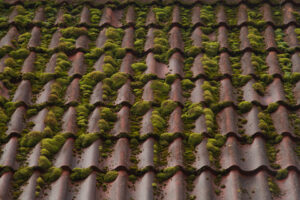Moss Removal From Tile Roofs
May 13, 2022
Can Moss Grow on Tile Roofs?
Absolutely, moss attaches itself to any organic material that is available, and uses this as its anchor, or base, for growing. All roofs are susceptible to moss growth, but moss is particularly common and damaging to tiled roofs in wet climates. If moss and lichen growth is left unchecked, it can lead to a number of serious long-term issues. Not only will moss make your roof look quite unsightly, but it can also cause structural damage and block your home’s drainage system.
Can Moss Damage a Tile Roof?
Tile roofing is durable and may provide many benefits when compared to other roofing options. However, even with how durable it is, the surface is porous and can still be damaged from moss, lichens, or algae growing on it.
- Moss acts like a sponge, collecting and holding water. In turn, moss growing on a porous tile roof often leads to softening. Then when temperature changes happen especially during winter months the trapped expanding and contracting moisture cracks and splits tiles.
- Once tiles crack and split, they allow moisture to seep into the underlying wood decking and other structural materials These will eventually rot and lead to interior home damage.
- Roofs are typically sloped or pitched to allow for proper drainage of rain and melting snow. Moss, algae, lichen, and other such growths block moisture’s path, resulting in standing water and the risk of severe roof damage.
- Storm debris, fallen leaves and twigs, acorns, moss, sap, and other residues on a roof might work their way in between and underneath tiles, loosening them and increasing the risk of losing them in a storm. These lifted areas also allow for water to seep into the roof decking.
- Neglecting storm debris, dirt, mud, and other such grime on a roof allows it to roll into the attached gutters, risking clogs and resultant water damage.
How to Clean a Tile Roof
The best tile roof cleaning method is to call a power washing contractor near you specializing in soft wash pressure washing! A professional power washing company ensures a safe, effective clean, as said, and your tile roof cleaning costs are often far lower than you might realize.
If you do want to attempt DIY tile roof cleaning, ensure you wear protective gear including shoes with good traction and safety glasses. When on your tile roof, note that the strongest point is where the tiles overlap, so try to keep yourself in those areas when working. You’ll also want to plan your work so that you can stay on a dry spot rather than walking on a wet roof; if needed, spread the cleaning over several hours or even two days so one area of the roof can dry thoroughly, giving you a safe walking surface.
- Always check the manufacturer’s advice on the recommended method of walking on a particular roof. Different companies make roofing systems different, hence the best way to ensure safety is by using instructions and illustrations from the manufacturer’s manual.
- Use fall protection and all required safety equipment and check that it meets OSHA standards of safety.
- Wear light-weight soft-soled shoes that are clean from any debris on the soles.
- Never walk on gutters, eave flashings, rake flashings, or hip and ridge flashings.
- Never walk on any skylights or fiberglass-type panels.
- Choose the right weather conditions (dry).